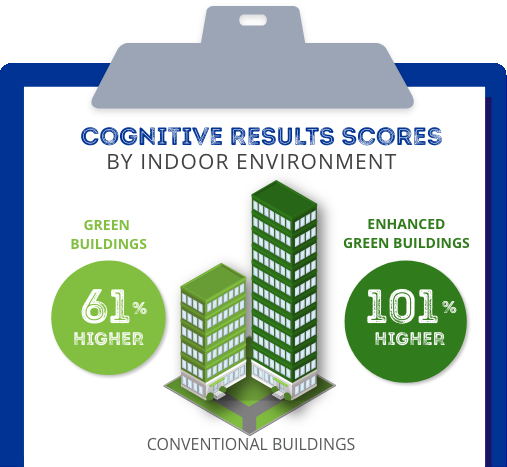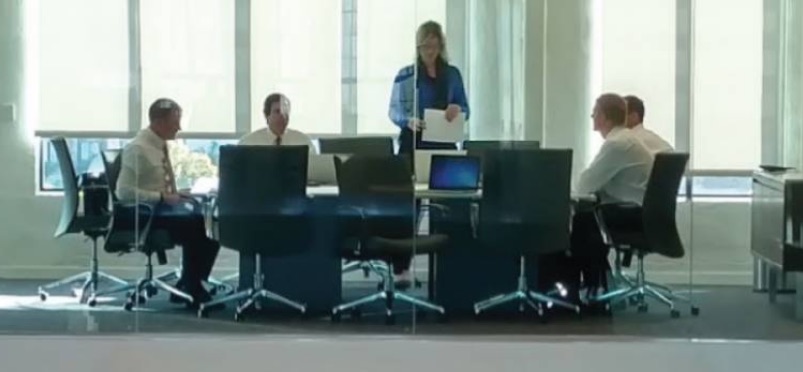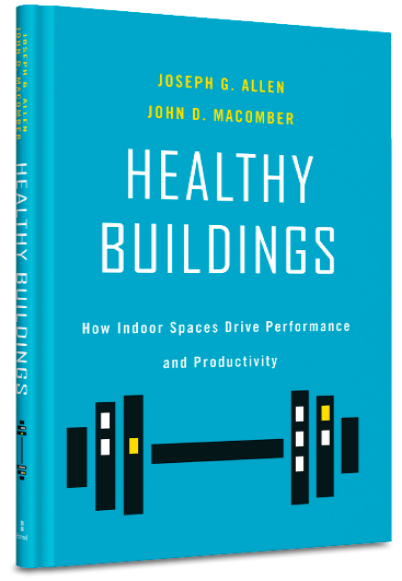The Global Mega-changes shaping our world, Our buildings, and us
The world is changing around us, and buildings are at the epicenter of that change. The decisions we make today regarding our buildings will determine our collective health for generations to come. We shape our buildings and afterward our buildings shape... our health, our business, and our planet. Of the 10 mega-changes shaping the world right now, buildings are at the center of them all.
Healthy buildings represent one of the greatest health — and business — opportunities ever.
Why Are we ignoring the 90%?
We spend 90% of our time indoors
We spend time in our homes, offices, cars, and an assortment of other places like restaurants, stores, gyms, and airplanes. For all this time spent indoors, we tend to focus much more on outdoor air quality than on our indoor air quality.
90% of true operating costs are spent on the people inside buildings
However, we focus on the easier-to-measure other 10%, rent and utilities. This 90% represents a massive financial opportunity going forward. The indoor environment matters for health and wealth.
What's your indoor age?
Enter your current age to see your indoor age.
It becomes obvious and intuitive that our indoor environment would have a disproportionate impact on our health.
The indoor environment's three-pronged assault on our health
The majority of your exposure to outdoor air pollution can occur indoors. There are a lot of factors – infiltration factors – that determine just how much outdoor air pollution enters a building. On average, a review of infiltration factors shows that a stable median estimate for commercial buildings and homes is ~50%. Knowing how much air pollution from outside is inside, and knowing how much time we spend inside, we know the majority of exposure to outside air pollution happens inside.
In addition to outdoor air pollution penetrating indoors, we also face indoor sources of air pollution. Frequently referenced estimates from the Environmental Protection Agency say indoor levels of some contaminants can be three to five times higher than outdoors. Buildings have been tightened up to limit how much fresh air gets in, in our efforts to save energy. Then, after we trap ourselves in these airtight chambers and become appalled at the odor we start to notice, we use sprays, candles, and scented cleaners. And then we douse ourselves with personal hygiene products so we smell good, and we have building materials and furniture that introduce pollutants in our sealed-up buildings and homes. The products we use in our offices, homes, and cars, and all the activities we perform there, all contribute to this indoor cocktail that our bodies are constantly absorbing and ingesting.
Even if you do your best to stop outdoor pollutants from penetrating inside and you’re careful of what’s happening in your space, there’s another thing to be concerned about, and that’s your neighbors. In commercial office buildings, your "neighbor" can be the building next door. Instances of one building’s ventilation exhaust feeding almost directly into the adjacent building’s air intake system are common. Restaurant exhaust billows into an adjacent building’s air intake system and there are even buildings whose air intakes are right at street level by idling cars and parking lots.
Putting the building to work for you
How do you attract the best and the brightest, and how do you retain them? Then, once you’ve hired them, how do you give them the opportunity to perform their best? It turns out that your building has a role to play in all of this, acting as a differentiator for recruitment and retention and optimizing employee productivity.
The person who manages your building has a bigger impact on your health than your doctor. And this person just may have as big an impact on your bottom line as your CFO.
What specific actions can we perform to start putting our building to work for us? The answer is literally right under our noses.



Read the study that set the benchmark for measuring ventilation and its impact on cognitive function
When workers were in an optimized indoor environment, meaning high ventilation rates, low VOCs, and low carbon dioxide, we found a dramatic improvement in higher-order cognitive functions.
The COGfx StudyThe impact of higher ventilation on your income statement
Click the buttons below to see their impact on a business:
Itemized impacts of healthy building decisions
| Baseline | OpExImpacts | Baseline + Healthy Buildings | ||
| Revenue | $6,000,000 | $6,000,000 | ||
| Payroll | $(3,000,000) | $(3,000,000) | ||
| Rent | $(300,000) | $(300,000) | ||
| Utilities | $(30,000) | -20% | $6,000 | $(24,000) |
| Other Expenses | ($1,000,000) | $(1,000,000) | ||
| Net income before taxes | $1,670,000 | $1,670,000 | ||
| Taxes (30%) | $501,000 | $$502,800 | ||
| Net income after taxes | $1,169,000 | $1,173,200 | ||
| Changes: | 0.36% | |||
| Baseline | OpExImpacts | Payroll Effect: Health | Baseline + Healthy Buildings | ||
| Revenue | $6,000,000 | $6,000,000 | |||
| Payroll | ($3,000,000) | -1% | $30,000 | $(2,970,000) | |
| Rent | ($300,000) | $(300,000) | |||
| Utilities | ($30,000) | $(30,000) | |||
| Other Expenses | ($1,000,000) | $(1,000,000) | |||
| Net income before taxes | $1,670,000 | $1,700,000 | |||
| Taxes (30%) | $501,000 | $510,000 | |||
| Net income after taxes | $1,169,000 | $1,190,000 | |||
| Changes: | 1.80% | ||||
| Baseline | OpExImpacts | Payroll Effect: Health | Productivity Boost: Health | Baseline + Healthy Buildings | |||
| Revenue | $6,000,000 | 2% | $120,000 | $6,120,000 | |||
| Payroll | ($3,000,000) | -1% | $30,000 | $(2,970,000) | |||
| Rent | ($300,000) | $(300,000) | |||||
| Utilities | ($30,000) | $(30,000) | |||||
| Other Expenses | ($1,000,000) | $(1,000,000) | |||||
| Net income before taxes | $1,670,000 | $1,820,000 | |||||
| Taxes (30%) | $501,000 | $546,000 | |||||
| Net income after taxes | $1,169,000 | $1,274,000 | |||||
| Changes: | 9.0% | ||||||
| Baseline | OpExImpacts | Payroll Effect: Health | Productivity Boost: Health | Baseline + Healthy Buildings | ||||
| Revenue | $6,000,000 | 3% | $180,000 | $6,180,000 | ||||
| Payroll | ($3,000,000) | -1% | $30,000 | $(2,970,000) | ||||
| Rent | $(300,000) | 10% | $(30,000) | $(330,000) | ||||
| Utilities | $(30,000) | $(1,600) | $(31,600) | |||||
| Other Expenses | $(1,000,000) | $(1,000,000) | ||||||
| Net income before taxes | $1,670,000 | $1,848,400 | ||||||
| Taxes (30%) | $501,000 | $554,520 | ||||||
| Net income after taxes | $1,169,000 | $1,293,880 | ||||||
| Changes: | 10.7% | |||||||
Baseline Company Assumptions
| Number of employees | 40 |
| Average salary | $75,000 |
| Payroll as % of revenue | 50% |
Creating and Capturing Value

Healthy building strategies are good business strategies. For many 21st-century “knowledge worker” businesses, people costs are by far the largest single portion of their income statement. Office rent may be second, and the two of them together might account for 90% of the cost of those firms. We argue that a work environment that helps people to improve their health, productivity, and creativity provides more bottom-line benefit than does scrimping on ventilation, filtration, material selection, and the incremental energy and operating costs.
The way we see it, one of the most accessible ways to influence the health of people around the world is to influence the design, operation, and maintenance of the billions of square feet of enclosed space where we live, work, learn, play, pray, and heal. We think that the key to making this theory of change operational is to show that it's a "win for all" scenario; that acting in your own self-interest can influence others to do the same, and that, building by building, we can begin to improve the health of all people, in all buildings, everywhere, every day.
A Healthy Building Strategy
The healthy buildings movement will require a new, holistic approach that jointly looks at a range of factors and systems, forcing interactions among various fields of expertise.
The 9 Foundations of a Healthy Building distills 40 years of research on the key determinants of health in a building. And, the CoBE calculator, built with purpose by Harvard researchers, helps to quantify the health benefits of energy efficiency measures in buildings.

The 9 Foundations of a Healthy Building
Clear and actionable core elements of healthy indoor environments
Learn More
CoBE: Health Co-benefits of the built environment
Built with purpose by Harvard researchers to quantify the health benefits of energy efficiency measures in buildings.
Learn MoreThe Healthy Buildings Book
A forensic investigator of "sick buildings" and director of Harvard’s Healthy Buildings Program teams up with a CEO-turned–Harvard Business School professor to reveal the secrets of a healthy building — and unlock one of the greatest business opportunities of our time.
By the time you reach 80, you will have spent 72 years of your life indoors. Like it or not, humans have become an indoor species. This means that the people who design, build, and maintain our buildings can have a major impact on our health.

Essential reading for all who commission, design, manage, and use buildings
-Lord Norman Foster


